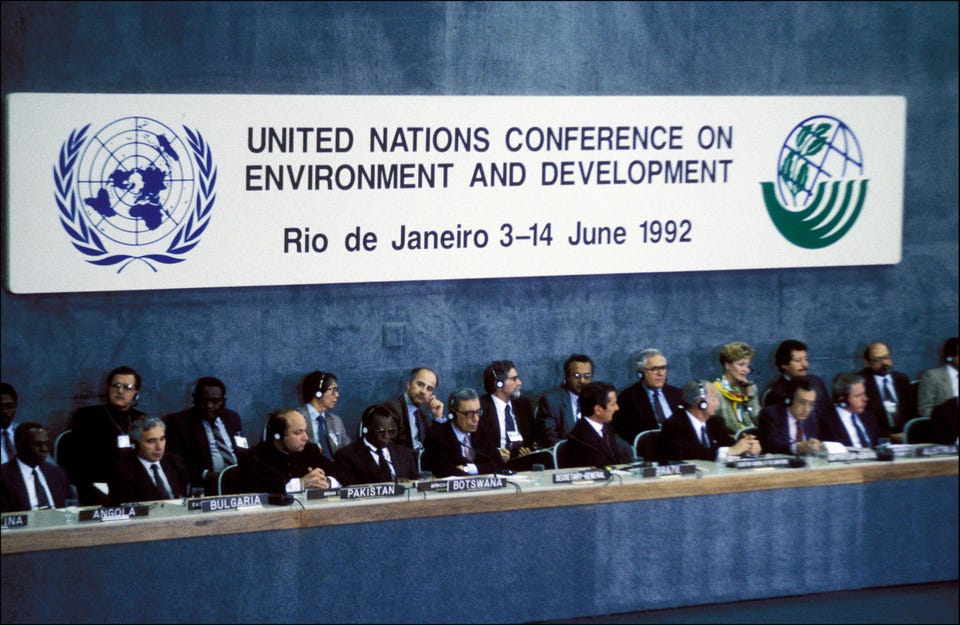Sustainability COP 27: How the UN’s Global Climate Conference First Started David Carlin Contributor Opinions expressed by Forbes Contributors are their own. Helping you to understand and thrive in our changing world Following New! Follow this author to stay notified about their latest stories. Got it! Nov 5, 2022, 07:56am EDT | New! Click on the conversation bubble to join the conversation Got it! Share to Facebook Share to Twitter Share to Linkedin The Rio Earth Summit established the UNFCCC and began the COP process.
Gamma-Rapho via Getty Images This is the first article in a series exploring the global climate meetings, the Conference of the Parties (COP). It explores the origin of the COP process in Rio, and the aims of the framework convention on climate change. Subsequent articles will cover the successes and failures of the Kyoto Protocol, the limited Copenhagen Accord, the Paris Agreement, and the key issues at COP 27.
Tens of thousands are descending on Sharm El-Sheikh, Egypt for the world’s biggest climate negotiation. Delegates from nearly two-hundred countries, dozens of world leaders, and hundreds of the biggest companies and NGOs will be there. With climate impacts worsening and the window to a 1.
5 C world rapidly closing, the stakes are higher than ever for the negotiations. Since the Paris Agreement in 2015, the media and the public have increasingly followed developments in these global climate meetings. However, to many, the nature of these climate conferences remains a mystery.
This series of articles explores how we arrived at COP 27, the progress made along the way, and key topics in this year’s negotiations. Where it began Rio 1992, global CO2 concentration: 356 ppm Officially, the meetings in Egypt are called the 27 th Conference of the Parties (COP 27) to the United Nations Framework Convention on Climate Change (UNFCCC). The “parties” in question are the 198 signatory states to that framework convention.
The framework convention is an international treaty agreed at the Rio Earth Summit in 1992. The abiding focus of that treaty is “to stabilize greenhouse gas concentrations in the atmosphere at a level that would prevent dangerous anthropogenic interference with the climate system. ” At the time of the Rio Earth Summit, policymakers around the world had become aware of the risks posed by human-induced climate change.
In 1988 in the United States, the eminent climate scientist James Hansen, testified at Congressional hearings on climate change that made headlines. That same year, the United Nations created the Intergovernmental Panel on Climate Change (IPCC) , a global body of scientists tasked with evaluating the latest research on climate change. The IPCC issued its first assessment report in 1990, asserting that “emissions resulting from human activities are substantially increasing the atmospheric concentrations of the greenhouse gases.
” MORE FOR YOU The ‘Backsies’ Billionaire: Texan Builds Second Fortune From Wreckage Of Real Estate Empire He’d Sold Freelance Stories: Australia’s Mash Shows The Value Of Bootstrapping Teeling Releases Stunning 32 YO Irish Single Malt Whiskey Mounting concern about climate change came about at a time of rising popular awareness of the fragility of nature as shown by the hole in the ozone layer, the polluted oceans, and the disappearing rainforests. In Rio, youth activist Severn Suzuki grabbed the world’s attention with an impassioned plea on behalf of “ all generations to come . ” Policymakers of the era had strong faith in the power of international agreements to solve environmental problems.
The 1987 Montreal Protocol ’s global cap on the use of ozone-depleting substances (ODS) has reduced their production by 98%. A bilateral agreement between the US and Canada effectively combatted acid rain by limiting the emission of sulfur dioxide (SO2). These successes helped to catalyze the desire for a unified commitment to combat climate change that became the UNFCCC that was signed in Rio.
The framework convention recognized that not all signatories had contributed equally to global emissions, nor would they have equal resources to combat climate change. These differences were acknowledged by the principle of “common but differentiated responsibilities and respective capabilities,” with the expectation that industrialized nations would lead climate action. However, all parties would support climate mitigation (emissions reductions) and adaptation efforts.
Although country-specific reduction targets were not part of the original UNFCCC, the agreement aimed to stabilize greenhouse gas emissions at 1990 levels by 2000. The framework convention came into effect in 1994. The following year, deliberations took place in Berlin on how to implement the framework.
At this first conference of the parties (COP 1) , an agreement was reached to meet annually to discuss action on climate change and emissions reductions. Over the next two years, an agreement was developed that would commit industrialized nations to reducing their emissions of the six most important greenhouse gases. This agreement would become the Kyoto Protocol.
In the next article, we will explore the terms and legacy of the Kyoto Protocol. As we will see, the protocol marked the first time nations attempted to adhere to tangible emissions commitments, and it laid an important foundation for the Paris Climate Agreement. However, Kyoto fell well short in its aim to limit global emissions.
Follow me on Twitter or LinkedIn . David Carlin Editorial Standards Print Reprints & Permissions.
From: forbes
URL: https://www.forbes.com/sites/davidcarlin/2022/11/05/cop-27-how-the-uns-global-climate-conference-first-started/



